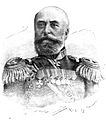Golden sword for bravery
The golden sword for bravery ( Russian : Золотое оружие "За храбрость") was a weapon of honor in the Russian Empire for bravery . The badge of honor was donated in 1720 by Tsar Peter the Great (1672–1725), it was partly based on the Order of St. Anne and the Order of St. George and initially consisted of a sword and later a sword and chest badge. It was awarded until the end of the First World War .
history
The tradition of the sword of honor in Russia goes back to the 17th century, the oldest specimen has the inscription on the blade: "His Majesty, the King and Grand Duke of all Russians Michail Fjodorowitsch gives this sword to Bogdan Khitrovo Matveeva". On July 27, 1720, Tsar Peter I awarded Mikhail Golitsyn a gold sword with diamonds . Since then, 300 swords of honor with diamonds have been awarded, 250 of them during the reign of Catherine II (1729–1796). The monetary value was then estimated at around 11,000 rubles (= approx. € 1700). In the course of the Russo-Austrian Turkish War , the swords were provided with the inscription "For Bravery", the "place name" and a keyword-like " Glory sheet " since 1788 , until 1790 84 of these golden swords were awarded with an individual value of around 560 rubles. An extraordinary production of a golden sword is in the Museum of the History of the Don Cossacks in Novocherkassk . It is a sword that Tsarina Catherine II presented to Count Matwei Ivanovich Platov in 1796 on the occasion of the Russian-Persian campaign , with a blade made of Damascus steel , a sword handle made of pure gold, set with 130 emeralds and diamonds , a wooden scabbard that covered with velvet and decorated with 306 diamonds, rubies and rock crystals .
At the time of Tsar Paul I (1754–1801) the weapon of honor was not awarded. Instead, the Golden Sword was linked to the Order of Saint Anne (4th grade). However, the sword of the Order of Anna was not placed in the classic series of the Golden Sword, as there was only a sword band (red and yellow) on the pommel in the 4th grade and was assigned to the Order of Annen. Tsar Alexander I (1777–1825) reintroduced the award of the original golden sword for bravery in 1805. The badge was now divided into three classes and was an Order of War Merit:
- Golden sword for valor with diamonds
- Golden sword for bravery
- Sword of the Order of Anna.
During the Napoleonic Wars , the award was awarded a total of 241 times in 1812 and a total of 685 times between 1813 and 1814. One of the recipients was Carl von Clausewitz , who was honored with this honor in 1819, who says in the awarding ukas:
“By the grace of God we Alexander the First etc. etc. To our major out of service Klausewitz As a reward for the zeal for service and excellent behavior, which you demonstrated in the battle against the French armies at the village of Borodino on August 26, 1812, where you during your service At the quartermaster - staff of the general of the cavalry Uvarov and showed excellent ability and bravery in this as well as in other battles, We most graciously gave you a golden saber of honor with the inscription "For bravery" on December 19, 1812 awarded. By our ukase of December 8th, 1817 We ordered the chapter of the Imperial Russian Order to sign this patent in witness and to affirm it with the seal of the order. Given at St. Petersburg, August 10, 1819. "
From 1829 onwards, only the awarded golden sword, with the inscription "For bravery", was considered the original award of the golden sword. Since 1855 it was customary to bestow the Golden Sword together with the 4th grade of the Order of Saint Anne. A revised guideline in 1859 stipulated that all officers up to the Colonel could only receive the award of the 4th class of the Order of St. Anne or the Order of St. George and that they were also presented with a breast badge. All generals and higher ranks were awarded the golden sword and the inscription "For bravery".
A further regulation of the award of the medal took place on September 1st, 1869, it stipulated that all appointed "Knights of the Order of Saint George" should be awarded the golden sword at the same time. As a result of this new regulation, 3384 officers and 162 generals were awarded the golden sword.
The next amendment to the award of the medal in 1878 stipulated that the generals received a normal steel sword with the award and were allowed to decorate it according to their own ideas and costs. The cross of the Order of St. George was now on the sword hilt with a ribbon in the colors black and yellow ( St. George's ribbon ). During the Russo-Japanese War from 1904 to 1905, the gold sword "For Bravery" with diamonds was given to four generals. The version of the golden sword for bravery was given to 406 officers. Another new variant followed in 1913, the sword received the cross of the Order of St. George engraved on the sword in white glaze. During the First World War, only eight dignitaries received the diamond-studded copy of the golden sword for bravery: Grand Duke Nikolai Nikolayevich , Vladimir Irmanov , Səməd bəy Mehmandarov , Sergei Dobrotin , Platon Letschitsky , Pyotr Kalitin , Alexei Alexejewitschwan Ivoivitsch and Anton Antonovich . After the First World War, the weapon and badge of honor were no longer given.
Grand Duke Nikolai Nikolayevich
Web links
- Золотое оружие «За храбрость» (Golden sword "for bravery") (Russian)
- Gold Sword for Valor, Auf: GDestoBesser - Library of Articles on Any Topic by Pavel Liprandi , accessed November 23, 2016









